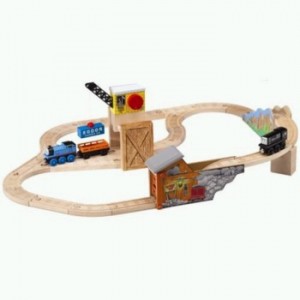
I visited a family child care provider in Bellevue last week. I’ve been working with Representative Ruth Kagi on trying to figure out how to improve both the reach and quality of our early learning system for at risk kids, and seeing how stuff works in person is pretty valuable.
This wasn’t a facility for at-risk kids. In fact, it costs over a thousand dollars a month for preschool kids, more for infants and toddlers. (They require a higher staff ratio.)
This isn’t an out of whack price – it’s what it costs to provide preschool here. We were looking at Washington’s new quality ranking system in action. The provider Bijay Singh has been working on getting rated, which is a long process. She’s been in the business for 30 years and it looked like a great place.
I’d show pictures, but I always feel awkward taking pictures of other people’s kids and there are legal issues with legal releases.
I have included the picture of Thomas the Tank Engine above, instantly recognizable to anyone who has had kids in the past 20+ years. (More people read posts with pictures – who knew?) I sat on the floor with a three-year-old and played with the boy and his trains for at least 10 minutes.
 The system of rating providers for quality is complex and based on a lot of research into what works. Our system is praised all over the country, but hasn’t really been put into place at scale yet.
The system of rating providers for quality is complex and based on a lot of research into what works. Our system is praised all over the country, but hasn’t really been put into place at scale yet.
You can read more about it here. Basically programs are rated on a 1-5 scale, with 3 being about the minimum level you would want your kid in.
Bijay talked me through what she’s doing – it involved a lot of work having interactive materials out and being much more intentional about her interactions with the kids.
She was super excited about it and could see a real difference in how it impacted her kids. She has a coach she can call on as she goes through the rating process.
Eventually (soon) all the ratings will be published and parents will be able to pick between programs based on an objective measure of the quality inherent in the program.
This is all well and good, but I’m most interested in how the system affects the availability of high-quality early learning opportunities for the kids who really need it.
Like almost every education measure, kids who grow up in poverty need high quality care just to be on the same footing with kids in more prosperous environments. The state has three programs for at-risk kids:
- Headstart is a federal program that typically provides a high level of care. There are about 8000 kids in Washington in Headstart.
- ECEAP is a terrible acronym for a similar program WA offers to low-income kids. It’s a 2.5 – 4 hour program (depending on the site) with similar features to Headstart. It also serves about 8000 kids. Almost all the kids are below 110% of the Federal Poverty Level (FPL), which is poor indeed.
- Over 50,000 kids are served, often for up to 10 hours a day in what we call Working Connections Child Care. (WCCC) This is an outgrowth of what we used to call Welfare, and is provided to make it possible for low-income single parents to actually work, and was part of the deal between Bill Clinton and Newt Gingrich that resulted in the redefinition of Welfare in the late 1990s.
About half of the ECEAP providers are rated a 3 or better. We have little data on the WCCC programs. We expect Headstart to do well on the rating system, but don’t have a lot of ratings in yet.
The challenge is to ensure that if we are going to pay for this much care, that we are getting the quality we need. We’re looking at paying more for higher-rated programs in our publicly supported care system.
This is called “tiered-reimbursement” and is how we need to move forward this year in Early Learning agenda.
I’m optimistic about the implementation of the rating system. As a parent, I want to know how good the program I’m putting my kid into is, and as a state we have a huge interest in not paying for low-quality care.

